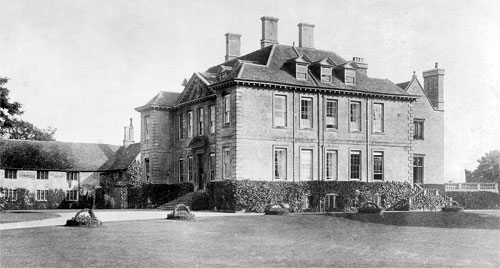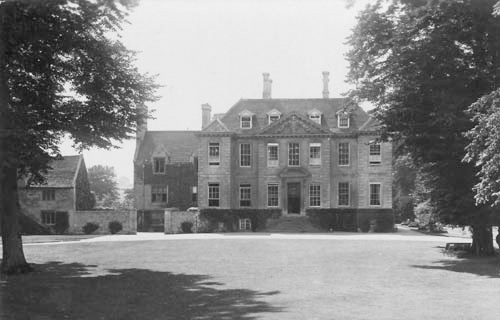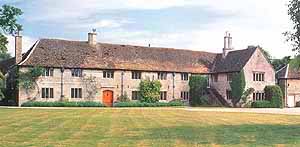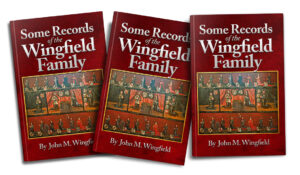
Tickencote Hall – Wingfield Home For 250 Years
By John Parry-Wingfield, of Empingham, England
Members of the WFS who have visited Tickencote, and indeed those who have the pleasure to come, may be interested in this brief history of Tickencote Hall, a Wingfield home for some 250 years and home of Sir John Wingfield (1592-1631), grandfather of Thomas Wingfield of York River, Virginia.
It was in 1593, just 14 years before Edward Maria Wingfield founded Jamestown, Virginia, that the first Wingfield became associated with Tickencote, a tiny village, 100 miles north of London, in Rutland, the smallest county in England. He was John Wingfield (1558-1616), second son of Sir Robert Wingfield of Upton (a village some 5 miles from Tickencote) and Elizabeth, sister of William Cecil, Lord Burghley, who was Lord Treasurer to Queen Elizabeth I. Sir Robert was grandson of Sir Henry Wingfield, the Governor of Orford Castle.
This John Wingfield was the first of a succession of twelve John Wingfields, interrupted only by Sir Richard Wingfield (1619-1663), to own Tickencote Hall and the surrounding land. He became Lord of the Manor of Tickencote by doing what more than one subsequent Tickencote Wingfield was to do; he married an heiress, in this case Elizabeth Gresham who, after a complicated series of transactions and law suits, had acquired the manor, together with 2,000 acres of land.
In 1602 John and Elizabeth Wingfield moved into Tickencote Hall. This was an existing manor house, of which very little is known, but it was probably the one described in an inquisition in 1433 on the death of the owner, Sir Thomas Daneys. This became the home of four generations of Wingfields until it was demolished to make way for a new Hall which was completed in 1706. Parts of the old house were at that time incorporated into an outbuilding which was used for stabling and storage until 1947 when, as will be explained later, it was converted into the residence now named Tickencote Hall.
Going back briefly to the 15th Century there is a colorful legend of the “Tickencote treasure” (sometimes known as the “Upton treasure”), a hoard of silver plate said to have been secreted at the time of the Wars of the Roses. Efforts to locate the treasure, which included a search by Lt. Col J. M. Wingfield in the early 20th Century, have so far been unsuccessful. (An adventure story by William le Oueux, loosely based on this legend and entitled, “The Tickencote Treasure” is well worth reading.)

The accompanying photo shows the 1906 Hall with the large Victorian extension at the rear. Before this extension was built the Hall was a four-story, stone built square building, with high chimneys, in the William and Mary style. It was imposing, but not especially elegant. Dr. Stukeley, the Stamford antiquarian, described it thus in his diary of 1717: “We had a sumptuous dinner and after cousin Wingfield showed us his house, which as he assured me had cost him ten thousand pounds building. It is built of stone; the apartments are not large, but convenient. He showed me a large number of family pictures; his ancestors have been knights of the Order of the Garter.” It has been suggested that the Hall was designed by the famous architect, Sir John Vanbrugh. This is not correct, but the true architect has not as yet been identified.
Tickencote Hall remained virtually unchanged through the 18th Century, but the 19th Century proved to be an eventful period. Anxious to improve the facilities of the site, John Wingfield (1763-1841) built a new water mill and created an artificial waterway two miles long to feed the mill pond. The mill, now converted into a dwelling house, can still be seen today.. Serious financial difficulties, however, resulted from the mill project. As Grace Wingfield expresses it in “Our Past”: “Possibly Mr. Wingfield’s bright and sanguine disposition may have led him to underestimate the cost of these undertakings. However that may be, or from whatever cause (the education of so large a family, 12 children, may well have been one), it was found about 1810 to 1813 that pecuniary difficulties had largely increased; part of the estate was mortgaged, and there was danger of the loss of the old and much prized inheritance, unless some prompt and strong action was taken.” The action taken was to sell property at the nearby village of Market Overton and in 1814 to let Tickencote Hall to tenants and take rented accommodation in Bath for 16 years until 1830.
At this point good fortune intervened; not only did John’s son, John Muxloe Wingfield (1790-1809), marry an heiress, Catherine Anne Harriet Lee (the Lee family was related to General Lee of American Civil War fame), but the property sold at Market Overton was bequeathed back to the Wingfields. John Muxloe was thus able to carry out a number of improvements to the house and to redesign the gardens. Much of the contents of his wife’s family home, Coton Hall in Shropshire, including a fine library, were at that time moved into Tickencote Hall.
The final period of Tickencote Hall as a Wingfield family home commenced in 1869 when John Muxloe’s eldest son, John Harry Lee Wingfield moved in. He too married into money, his wife, Elizabeth Anne Johnson, bringing more paintings and other possessions to the Hall. In 1872 a massive extension was built on the rear, garden side of the extension was in a style which may well have had some similarity to the architecture of the Hall demolished in 1700. It did not, however, blend very happily with the style of the 1706 building, although, being largely hidden at the back, it was not unduly offensive. Nevertheless the Wingfields of those prosperous mid-Victorian period now had a substantial house, with 20 bedrooms and 5 reception rooms, giving them a splendid base for the entertainment of friends and for gatherings of the numerous relations then living in the area around Tickencote. The building was enhanced by its setting at the foot of a picturesque village and beside a bend in the River Gwash.
John Henry Lee was not able to enjoy this for long, as he died in 1880, leaving the Hall to his eldest son, John Maurice Wingfield (1863-1931), author of “Some Records of the Wingfield Family.” After service in the Coldstream Guards for some 18 years, John Maurice took possession of the Hall in 1904 and energetically set about modernizing it. He introduced central heating, redesigned the lighting and plumbing and created an extensive water garden (now being restored by the current owners). The Hall continued to be used for the entertainment of family and friends but John Maurice was a bachelor and thus it was no longer a family home. In 1924, to quote his own words, he was “obliged to let the house and shooting owing to the very large increase in taxation.”
The decline and eventual fall of Tickencote Hall can be related briefly. In 1931 John Maurice Wingfield died and ownership of the Hall passed to his nephew, John (Jack) Parry-Wingfield (my father), the only male grandson of John Harry Lee Wingfield. Up to World War II it was let and for part of the war it was occupied by Canadian Servicemen. When Jack returned to England in 1945 he found it in a sorry state owing to lack of maintenance and to the vandalism which ensued after the house was vacated by the Canadians.
Having neither the resources to maintain it nor the desire to live in this huge building, Jack had no alternative but to sell the Hall. But demand for such buildings in those grim post-war years was virtually non-existent and eventually, in 1947 Jack sold the Hall to the only available purchaser, a builder, who purchased it for the value of the stone and other materials and promptly demolished it. So ended the Wingfield connection with Tickencote Hall two and a half centuries after it began.

On a happier note, the name of Tickencote Hall lives on. Since the purchaser converted into a beautiful dwelling house the stable block which, as related earlier in this article, had been constructed in 1706 from the remains of the earlier Hall. This is the present Tickencote Hall, improved by subsequent owners, and latterly by Peter and Tarn Dearden, which enchanted members of the WFS who visited it in May, 1988.
And what are the contents of the Hall? I have an inventory taken at the time of John Maurice’s death in 1931. It covers 59 foolscap pages and lists the 70 family portraits, 3,761 books and all the other heterogeneous items collected by 11 generations of Wingfields. The list concluded with “A black pony, aged.” All these items, except for a very few retained by my father, and the pony, which had presumably died, were sold by auction in 1947. I have records of many of the prices fetched, which are of course derisory by today’s standards, but no information on who made the purchases. It is said that a number of the portraits found their way to the United States.
It may be that my brother and I are the last remaining Wingfields with any knowledge of the original Hall. We spent summer holidays there in the immediate post-war years; I was 11 to 12 at the time. I recall the magnificence of the house and its setting by the river; the down at heel appearance of the interior, with furniture piled high in the main rooms and the remainder empty; and the extensive gardens and orchards still well maintained by a single gardener, where previously there had been four. In 1947 we stayed away and when we returned in 1948 the site of the house had been leveled for a lawn. Many other country houses were lost at this time and some 10 years ago they were recorded in an exhibition at the Victorian and Albert Museum entitled, “The Lost Country Houses of Britain”; the photo accompanying this article were among those included.
The irony is that now all such buildings are listed and preserved by law. For Wingfields the destruction of Tickencote Hall is especially sad, but we are fortunate that the family is well researched and recorded and Tickencote Hall can continue to live in our imagination.



